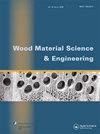The effect of laminate configuration on the mechanical properties of model glued-laminated timber composed of single and mixed tropical fast-growing tree species
IF 2.1
3区 农林科学
Q1 MATERIALS SCIENCE, PAPER & WOOD
引用次数: 0
Abstract
ABSTRACT The effects of laminate configuration on mechanical properties were investigated for model glued-laminated timber (GLT) composed of single and mixed fast-growing tree species (Acacia mangium Willd., Maesopsis eminii Engl., and Melia azedarach L.), which were grown in community forests in Indonesia. The simulation of lamina yield was decreased in graded GLT compared with that in GLT with randomly designed, while the mean values of simulated dynamic Young’s modulus (DMOE) in graded GLT were higher than those of GLT with randomly designed in each species. Graded GLT with mixed species should be produced to effectively utilize wood resources from fast-growing tree species. All mechanical properties showed higher values in single-species GLT especially for graded GLT, compared with solid lumber, suggesting that laminate configuration was effective for increasing mechanical properties. However, the factors that increase mechanical properties in single-species GLT differed among species. These factors can be evaluated by load-deflection curves. In GLT composed of single and mixed species produced with the same DMOE, almost all other mechanical properties were similar among laminate configurations. It is concluded that laminate configurations with different species and grades are useful for efficiently producing GLT with higher mechanical properties from multiple fast-growing tree species.层压板结构对热带速生树种单一和混合胶合层压板力学性能的影响
摘要研究了由生长在印度尼西亚群落林中的单一和混合速生树种(Acacia mangium Willd.、Maesopsis eminii Engl.和Melia azedarach L.)组成的模型胶合层压板(GLT)的层压板配置对力学性能的影响。与随机设计的GLT相比,分级GLT的叶片产量模拟有所下降,而分级GLT中模拟动态杨氏模量(DMOE)的平均值高于每个物种的随机设计GLT。应生产混合品种的分级GLT,以有效利用速生树种的木材资源。与实心木材相比,单一物种GLT的所有机械性能都显示出更高的值,尤其是分级GLT,这表明层压板配置对提高机械性能是有效的。然而,提高单一物种GLT力学性能的因素因物种而异。这些因素可以通过荷载-挠度曲线进行评估。在由用相同DMOE生产的单一和混合物种组成的GLT中,在层压板配置中,几乎所有其他机械性能都相似。得出的结论是,不同种类和等级的层压板配置有助于从多种快速生长的树种中有效地生产具有更高机械性能的GLT。
本文章由计算机程序翻译,如有差异,请以英文原文为准。
求助全文
约1分钟内获得全文
求助全文
来源期刊

Wood Material Science & Engineering
Materials Science-General Materials Science
CiteScore
3.90
自引率
13.60%
发文量
131
审稿时长
79 days
期刊介绍:
Wood Material Science and Engineering is a multidisciplinary and international journal with the aim to serve at the forefront of the wood science and technology field. The journal publishes original articles on basic and applied research dealing with:
-Wood material science with emphasis on: water-wood relations, wood durability, wood modification, wood mechanics, wood composites, engineered wood products, energy conversion and eco-efficient wood based products.
-Wood engineering, i.e. the application of the wood material science to designing, processing and manufacturing of forest products and the use of machines and processes for these products. Products of concern are biofuels, sawn wood and further refined products such as structural elements, interior fittings and furnishings. In this aspect the link between the nature of the wood material and the properties of the final wood products in-service and its impact on the environment is of outmost importance.
High quality review papers may also be accepted but the topic should be discussed with the editor before submission.
 求助内容:
求助内容: 应助结果提醒方式:
应助结果提醒方式:


